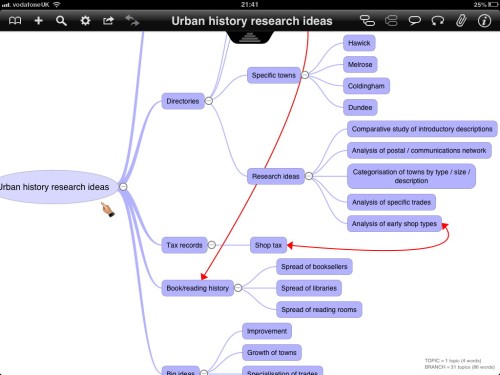Earlier this year I researched the history of this building, the first time I’d done that type of historical research. And I thought it might be useful to reflect on my experiences of doing it.
I did have some advantages going in. My postgraduate taught Masters degree was partly in urban history, taught by architectural historian Professor Charles McKean. So I picked up some tips. As well I had my academic historical research experience, and 35+ years as an amateur genealogist. So I was well used to researching people in the past, and the main sources that can help. But this was still a new challenge.
I was prompted to do it when I spotted that 2018 was the 200 year anniversary of the building where my husband works, now the HQ for the space technology company STAR-Dundee. They are a Dundee University spinoff company, and the building used to be university owned. Earlier its history was much less clear, though it was believed to have been a merchant’s house originally, and built for a man called James Gray.
So not too much to go on, when I wackily emailed STAR-Dundee boss Stuart in early April and offered to trace the history of the building and is inhabitants over two centuries. I wasn’t optimistic about what I’d find.
One of the first things I did was to check the architectural records held by Historic Environment Scotland. The Canmore database listing for the building mentions it was called Grange House. Well, I found that was wrong, probably from someone – quite possibly even my PhD supervisor Charles! – misreading the original architect plans, that, miraculously, the HES search room holds, as part of a volume of plans by the building’s architect David Neave. That sort of survival just doesn’t usually happen for buildings of this age. I was able to order digital copies of the original plans, and get permission from HES to reproduce them in my finished report. The plans show how the building, which went by the name Graybank for much of its history, was laid out in 1818 as a house, including the use of each room. The 1818 plans also included front and rear elevations of the house, which gave a lovely insight into what the building originally looked like – remarkably similar to now.
Alongside that I was able to quickly check records from core sources. Most were readily available online. For example the National Library of Scotland has a marvellous digitised collection of local directories, showing the occupants over time. Likewise ScotlandsPeople.gov.uk has all the 19th century census returns, digitised valuation rolls, wills and inventories, and much else besides. As a disabled academic, being able to access so much material online, conveniently and easily, was a real benefit, and speeded up the building research process enormously. For example from ScotlandsPeople.gov.uk I was able to download digital copies of the detailed lengthy wills and after-death inventories of many of the house’s owners, allowing me to transcribe them conveniently at home, and add much useful information to the finished report. This included the original owner, James Gray, whose inventory recorded the many ships he was a part owner of. We now have a confirmed vision of him watching for some of his ships from the vantage point of his new riverside house!
Perhaps most surprisingly – although maybe I shouldn’t have been too surprised – was the wealth of material found in old newspapers, searched by keyword search on the British Newspaper Archive website. These provided much rich detail about the house and its occupants. There were a number of sale or rental advertisements, describing it at different points. But there were also lots of marvellous obituaries for the various members of the family, and also mentions of family celebrations. One particular delight concerned a resident’s time before he moved into 166 Nethergate, revealing that he’d given a talk at Dundee University on the history of the solar system. A marvellous find given that the building is now the home of a space company!
We also managed to trace the family grave of the original owner in Dundee’s Howff cemetery, and my husband photographed it, to go into the report. A nearby Flowerdew family gravestone can’t be read any more, but we were able to find a record of its original inscription. Overall we were able to manage to find lots about the families who lived in the building for its first 130 years – Gray, Flowerdew, Lowson, Buist, Moodie plus some others in between – even in some cases tracing family photos and home movies from the 1930s.
The university connection was valuable from a research point of view. As a university property, a wealth of paperwork was preserved relating to the house from the late 1940s through to its sale to STAR-Dundee in 2011. This included more architectural plans, but also original surveyor reports, correspondence relating to the sale and use of the building, and even a duplicate old key lurking in the paper files! All of this information filled out the picture immensely.
In the end, in just about 10 weeks, I was able to compile a detailed report about the building and history, 48 pages long, in A4 format. We arranged for this to be printed and bound, and copies were given to STAR-Dundee, and posters about the building’s history put up for employees to look at. Copies of the printed report were deposited with Historic Environment Scotland’s archive in Edinburgh, and Dundee University Archives, so people can still access the research in 50, 100 or more years time.
Would I research a building’s history again? Yes, probably, though almost certainly with more modest expectations of what I might be able to uncover for another case. I think this first one rather spoilt me in terms of being so rich in source material, and, yes, those original plans. Enormous fun anyway.

Photo of 166 Nethergate
Read Full Post »




